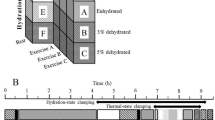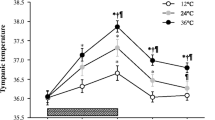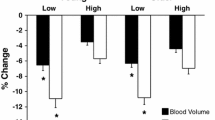Summary
The effects of euhydration (Eh) and light (Dh1) and moderate (Dh2) dehydrations on plasma prolactin (PRL) levels were studied in 5 young male volunteers at rest and during exercise to exhaustion (50% of\(\dot V_{{\text{O}}_{{\text{2}} {\text{max}}} } \)) in a warm environment (Tdb=35° C, rh=20–30%). Light and moderate dehydrations (loss of 1.1 and 1.8% body respectively) were obtained before exercise by controlled hyperthermia. Compared to Eh, time for exhaustion was reduced in Dh1 and Dh2 (p<0.01) and rectal temperature (Tre) rose faster in Dh2 (p<0.05). Both venous plasma PRL and norepinephrine (NE) increased during exercise at any hydration level (p<0.05). Plasma PRL reached higher values after 40 and 60 min in Dh2 and Dh1 (p<0.05). Plasma NE values were higher in Dh2 at rest and at the 40th min during exercise (p<0.05). Plasma PRL was linearly correlated to Tre and plasma NE (p<0.001) but unrelated to plasma volume variation and osmolality. Our results provide further evidence for the major effect of body temperature in exercise-induced PRL changes. Moreover, the plasma PRL-NE relationship suggests that these changes may result from central noradrenergic activation.
Similar content being viewed by others
Abbreviations
- Tdb:
-
dry bulb temperature
- rh:
-
relative humidity
- PRL:
-
prolactin
- NE:
-
norepinephrine
- HR:
-
heart rate
- Tre:
-
rectal temperature
- ¯Tsk:
-
mean skin temperature
- Eh:
-
euhydration test
- Dh1 :
-
light dehydration test
- Dh2 :
-
moderate dehydration test
References
Brammert M, Hökfelt B (1987) The influence of naloxone on exercise-induced increase in plasma pituitary hormones and the subjectively experienced level of exhaustion in healthy males. Acta Endocrinol 115:125–130
Brisson GR, Ledoux M, Péronnet F, Dulac S, DeCarufel D, Volle MA, Rainville J, Audet A (1981) Prolactinemia in exercising male athletes. Horm Res 15:218–223
Brisson GR, Péronnet F, Dulac S, Ledoux M, Nadeau M, Leblanc J, Quirion A, DeCarufel D (1983) Plasma prolactin, norepinephrine and epinephrine during prolonged exercises performed under different thermal conditions. Med Sci Sports Exerc 15:95
Brisson GR, Audet A, Ledoux M, Matton P, Pellerin-Massicotte J, Péronnet F (1986a) Exercise-induced blood prolactin variations in trained adult males: a thermic stress more than an osmotic stress. Horm Res 23:200–206
Brisson GR, Péronnet F, Ledoux M, Pellerin-Massicotte J, Matton P, Garceau F, Boisvert P Jr (1986b) Temperature-induced hyperprolactinemia during exercise. Horm Metabol Res 18:283–284
Brown BS, Payne T, Kim C, Moore G, Krebs P, Martin W (1979) Chronic response of rat brain norepinephrine and serotonin levels to endurance training. J Appl Physiol: Respirat Environ Exercise Physiol 46:19–23
Buckman MT, Peake GT (1973) Osmolar control of prolactin secretion in man. Science 181:755–757
Christensen SE, Jørgensen O, Møller J, Møller N, Ørskov H (1985) Body temperature elevation, exercise and serum prolactin concentrations. Acta Endocrinol 109:458–462
Colin J, Timbal J, Houdas Y, Boutelier C, Guieu JD (1971) Computation of mean body temperature from rectal and skin temperatures. J Appl Physiol 31:484–489
Da Prada M, Zürcher G (1976) Simultaneous radioenzymatic determination of plasma and tissue adrenaline, noradrenaline and dopamine within fento-mole range. Life Sci 19:1161–1174
Day TA, Jervois PM, Menadue MF, Willoughby JO (1982) Catecholamine mechanisms in medio-basal hypothalamus influence prolactin but not growth hormone secretion. Brain Res 253:213–219
De Meirleir KL, Baeyens L, L'Hermite-Baleriaux M, L'Hermite M, Hollmann W (1985) Exercise-induced prolactin release is related to anaerobiosis. J Clin Endocrinol Metab 60:1250–1252
Dill DB, Costill DL (1974) Calculation of percentage changes in volumes of blood, plasma, and red cells in dehydration. J Appl Physiol 37:247–248
Elam M, Svensson TH, Thorén P (1987) Brain monoamine metabolism is altered in rats following spontaneous, long-distance running. Acta Physiol Scand 130:313–316
Farrell PA (1985) Exercise and endorphins — male responses. Med Sci Sports Exerc 17:89–93
Farrell PA, Gustafson AB, Garthwaite TL, Kalkhoff RK, Cowley AW Jr, Morgan WP (1986) Influence of endogenous opioids on the response of selected hormones to exercise in humans. J Appl Physiol 61:1051–1057
Galbo H, Holst JJ, Christensen NJ (1975) Glucagon and plasma catecholamine responses to graded and prolonged exercise in man. J Appl Physiol 38:70–76
Gold MS, Redmond DE Jr, Donabedian RK (1979) The effects of opiate agonist and antagonist on serum prolactin in primates: possible role for endorphins in prolactin regulation. Endocrinology 105:284–289
Henane R, Valatx JL (1973) Thermoregulatory changes induced during heat acclimatization by controlled hyperthermia in man. J Physiol 230:255–271
Ježová D, Johansson BB, Olsson Y, Opršalová Z, Kiss A, Jurčovičová J, Grässler J, Westergren I, Vigaš M (1988) Can catecholamines and other neurotransmitters cross the blood brain barrier and modify neuroendocrine function under stress? In: Kvetnansky R, Axelrod J (eds) Catecholamines and other neurotransmitters in stress. Gordon and Breach Science Publishers, New York, pp 38 (in press)
Koshiyama H, Kato Y, Ishikawa Y, Murakami Y, Inoue T, Imura H (1987) Stimulation of prolactin secretion byl-3,4-dihydroxyphenylserine (l-DOPS) via central norepinephrine in the rat. Life Sci 41:983–988
Maas JW (1984) Relationships between central nervous system noradrenergic function and plasma and urinary concentrations of norepinephrine metabolites. In: Usdin E, Åsberg M, Bertilsson L, Sjöqvist F (eds) Frontiers in biochemical and pharmacological research in depression. Raven Press, New York, pp 45–55
Mills DE, Robertshaw D (1981) Response of plasma prolactin to changes in ambient temperature and humidity in man. J Clin Endocr Metab 52:279–283
Odink J, Van der Beek EJ, Van den Berg H, Bogaards JJP, Thissen JTNM (1986) Effects of work load on free and sulfate-conjugated plasma catecholamines, prolactin and cortisol. Int J Sports Med 7:352–357
Pequignot JM, Peyrin L, Mayet MH, Flandrois R (1979) Metabolic adrenergic changes during submaximal exercise and in the recovery period in man. J Appl Physiol 47:701–705
Peyrin L, Pequignot JM, Lacour JR, Fourcade J (1987) Relationships between catecholamine or 3-methoxy 4-hydroxy phenylglycol changes and the mental performance under submaximal exercise in man. Psychopharmacology 93:188–192
Ragavan W, Frantz AG (1981) Opioid regulation of prolactin secretion: evidence for a specific role ofβ-endorphin. Endocrinology 109:1769–1771
Shum A, Johnson GE, Flattery KV (1969) Influence of ambient temperature on excretion of catecholamines and metabolites. Am J Physiol 216:1164–1169
Smallridge RC, Whorton NE, Burman KD, Fergusson EW (1985) Effects of exercise and physical fitness on the pituitary-thyroid axis and on prolactin secretion in male runners. Metabolism 34:949–954
Vogel RB, Books CA, Ketchum C, Zauner CW, Murray FT (1985) Increase of free and total testosterone during submaximal exercise in normal males. Med Sci Sports Exerc 17:119–123
Von Euler US (1974) Sympatho-adrenal activity in physical exercise. Med Sci Sports 6:165–173
Author information
Authors and Affiliations
Rights and permissions
About this article
Cite this article
Melin, B., Curé, M., Pequignot, J.M. et al. Body temperature and plasma prolactin and norepinephrine relationships during exercise in a warm environment: effect of dehydration. Europ. J. Appl. Physiol. 58, 146–151 (1988). https://doi.org/10.1007/BF00636618
Accepted:
Issue Date:
DOI: https://doi.org/10.1007/BF00636618




